.
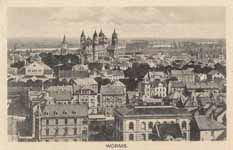

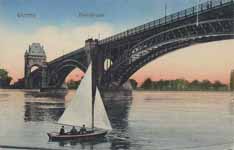


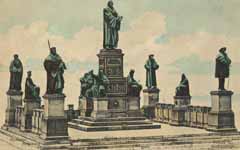
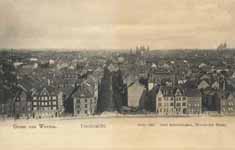
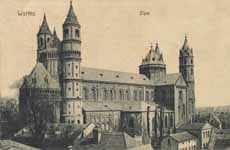

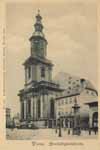
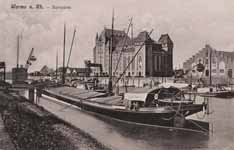
Worms
Worms (German pronunciation: [ˈvɔɐ̯ms]) is a city in Rhineland-Palatinate, Germany, on the Rhine River. At the end of 2004, it had 85,829 inhabitants.
Established by the Celts, who called it Borbetomagus, Worms today remains embattled with the cities Trier and Cologne over the title of "Oldest City in Germany." Worms is the only German member of the Most Ancient European Towns Network.[2][3]
Today the city is an industrial centre and is famed for the original "Liebfrauenstift-Kirchenstück" epotoponym for the Liebfraumilch wine. Other industries include chemicals and metal goods.
Worms is one of the major sites where the events of the ancient German Nibelungenlied took place. A multimedia Nibelungenmuseum was opened in 2001, and a yearly festival right in front of the Dom, the Cathedral of Worms, attempts to recapture the atmosphere of the pre-Christian period.
Etymology
Worms' name is of Celtic origin: Borbetomagus meant "settlement in a watery area". This was eventually transformed into the Latin name Vormatia that had been in use since the 6th century, which was preserved in the Medieval Hebrew form Vermayza (ורמיזא). Many fanciful variant names for Worms exist only upon the title pages of books printed when Worms was an early centre of printing: for instance William Tyndale's English translation of the New Testament was printed at Worms in 1526.
Geography
Geographic location
Worms is located on the west bank of the Rhine River in between the cities of Ludwigshafen and Mainz. On the northern edge of town the Pfrimm flows into the Rhine, and on the southern edge of the city the Eisbach, or "Ice Stream" in English, flows into the Rhine.
Boroughs of Worms
Worms has 13 boroughs (or "Quarters") that surround the city center. They are as follows:
Name Population Distance from Worms city center
Abenheim 2.744 Northwest of City Center (10 km)
Heppenheim 2.073 Southwest of City Center (9 km)
Herrnsheim 6.368 North of City Center (5 km)
Hochheim 3.823 Northwest of City Center
Horchheim 4.770 Southwest of City Center (4.5 km)
Ibersheim 692 North of City Center (13 km)
Leiselheim 1.983 West of City Center (4 km)
Neuhausen 10.633 North of City Center
Pfeddersheim 7.414 West of City Center (7 km)
Pfiffligheim 3.668 West of City Center
Rheindürkheim 3.021 North of City Center (8 km)
Weinsheim 2.800 Southwest of City Center (4 km)
Wiesoppenheim 1.796 South West of City Center (5.5 km)
Climate
The climate in the Rhine River Valley is very temperate in the winter time and quite enjoyable in the summertime. Rainfall is below average for the surrounding areas. Snow accumulation in the winter is very low and often melts within a short period of time.
History
Imperial City of Worms
Reichsstadt Worms
Free Imperial City of the Holy Roman Empire
← Duchy of Franconia
11th century–1789 →
Capital Not specified
Government Republic
Historical era Middle Ages
- City founded before 14 BC
- Gained Reichsfreiheit between 1074 and 1184
- Concordat of Worms 1122
- Reichstag concluded
Imperial Reform
1495
- Diet of Worms:
Martin Luther banned
1521
- Sacked by French during
War of Grand Alliance
1689
- Occupied by France 1789–1816
- Awarded to Hesse 1816
Jewish Cemetery "Heiliger Sand".
Heylshof Garden.
Vineyards.
Map of Worms in 1630. The Jewish Ghetto is marked in yellow.
Celts and Romans
The city has existed since before Roman times, when it was captured and fortified by the Romans under Drusus in 14 BC. From that time, a small troop of infantry and cavalry were garrisoned in Augusta Vangionum; this gave the settlement its Romanized but originally Celtic name Borbetomagus. The garrison developed into a small town with the regularized Roman street plan, a forum, and temples for the main gods Jupiter, Juno, Minerva (upon whose temple, as is usual, was built the cathedral) and Mars.
St Martin's Church.
Roman inscriptions and altars and votive offerings can be seen in the archaeological museum, along with one of Europe's largest collections of Roman glass. Local potters worked in the south quarter of the town. Fragments of amphoras show that the olive oil they contained had come from Hispania Baetica, doubtless by sea and then up the Rhine. At Borbetomagus, Gunther king of the Burgundians, set himself up as puppet-emperor, the unfortunate Jovinus, during the disorders of 411–13. The city became the chief city of the first kingdom of the Burgundians, who left few remains; however, a belt clasp from Worms-Abenheim is a museum treasure. They were overwhelmed in 437 by Hun mercenaries called in by the Roman general Aëtius to put an end to Burgundian raids, in an epic disaster that provided the source for the Nibelungenlied.
Middle Ages
Worms was a Roman Catholic bishopric since at least 614 with an earlier mention in 346. In the Frankish Empire, the city was the location of an important palatinate of Charlemagne (Karl der Grosse), who built one of his many administrative palaces here. The bishops administered the city and its territory. The most famous of the early medieval bishops was Burchard of Worms.
Worms Cathedral (Wormser Dom), dedicated to St Peter, is one of the finest examples of Romanesque architecture in Germany. Alongside the nearby Romanesque cathedrals of Speyer and Mainz, it is one of the so-called Kaiserdome (Imperial Cathedrals). Some parts in early Romanesque style from the 10th century still exist, while most parts are from the 11th and 12th century, with some later additions in Gothic style (see the external links below for pictures).
Four other Romanesque churches as well as the Romanesque old city fortification still exist, making the city Germany's second in Romanesque architecture only to Cologne.
Golden Age
Worms prospered in the High Middle Ages. Having received far-reaching privileges from King Henry IV (later Emperor Henry III) as early as 1074, the city later became a Reichsstadt, being independent of a local territory and responsible only to the Emperor himself. As a result, Worms was the site of several important events in the history of the Holy Roman Empire. In 1122 the Concordat of Worms was signed; in 1495, a Reichstag concluded here made an attempt at reforming the disintegrating Imperial Circle Estates of the Reichsreform (Imperial Reform). Most important, among more than a hundred Imperial Diets held at Worms, the Reichstag of 1521 (commonly known as the Diet of Worms) ended with the Edict of Worms at which Martin Luther was declared an outlaw after refusing to recant his religious beliefs. The first complete edition of the New Testament in English, translated from the original Greek (as opposed to the Latin Vulgate) by William Tyndale, was secretly printed in Worms in 1526.
Modern era
In 1689 during the Nine Years' War, Worms (like the nearby towns and cities of Heidelberg, Mannheim, Oppenheim, Speyer and Bingen) was sacked by troops of King Louis XIV of France, though the French only held the city for a few weeks. In 1743 the Treaty of Worms was signed, ending the Second Silesian war between Prussia and Austria. In 1792 the city was occupied by troops of the French First Republic during the French Revolutionary Wars. The Bishopric of Worms was secularized in 1801, with the city being annexed into the First French Empire. In 1815 Worms passed to the Grand Duchy of Hesse in accordance with the Congress of Vienna and subsequently administered within Rhenish Hesse.
After the Battle of the Bulge, Allied Armies advanced into the Rhineland in preparation for a planned massive assault across the Rhine into the heart of the Reich. Worms was a German strong point in the southern Rhineland on the West bank of the Rhine and the German forces there resisted the Allied advance tenaciously. Worms was thus heavily bombed by the Royal Air Force during the last few months of World War II — in two attacks, on Feb. 21 and March 18, 1945. A post-war survey estimated that 39 per cent of the town's developed area was destroyed. The RAF attack on Feb. 21 was aimed at the main train station, on the edge of the inner city, and at chemical plants southwest of the inner city. The attack, however, also destroyed large areas of the city center. The attack was carried out by 334 bombers that in a few minutes rained 1,100 tons of bombs on the inner city. The Worms Cathedral was among the buildings set afire in the resulting conflagration. The Americans did not enter the city until the Rhine crossings began after the seizure of the Remagen Bridge.
In the attacks, 239 inhabitants were killed and 35,000 (60 percent of the population of 58,000) were rendered homeless. A total of 6,490 buildings were severely damaged or destroyed. After the war, the inner city was rebuilt, mostly in modern style. Postwar, Worms became part of the new state of Rhineland-Palatinate; the borough Rosengarten, on the east bank of the Rhine, was lost to Hesse.
Judaism in Worms
The city, known in Medieval Hebrew under the name Vermayza or Vermaysa (ורמיזא, ורמישא), is known as a former center for Judaism. The Jewish community was established in the late 10th century, and the first synagogue was erected in 1034. In 1096, 800 Jews were murdered by crusaders and the local mob. The Jewish Cemetery in Worms, dating from the 11th century, is believed to be the oldest in Europe. The Rashi Synagogue, which dates from 1175 and was carefully reconstructed after its desecration on Kristallnacht, is the oldest in Germany. Prominent rabbis of Worms include Shlomo Yitzhaki (Rashi), Elazar Rokeach and Yair Bacharach. At the Rabbinical Synod held at Worms at the turn of the 11th century, rabbi Gershom ben Judah (Rabbeinu Gershom) explicitly prohibited polygamy for the first time.
For hundreds of years, uninterrupted, the Jewish Quarter was the centre of Jewish life until Kristallnacht in 1938, when much of the Jewish Quarter was destroyed. Worms today has only a very small Jewish population and a recognizable Jewish community as such no longer exists. However, after renovations in the 1970s and 1980s, many of the buildings of the Quarter can be seen in a close-to-original state, preserved as an outdoor museum.
In 2010 the synagogue was fire bombed. Eight corners of the building were set ablaze, and a Molotov cocktail was thrown at a window. There were no injuries. However Kurt Beck, Minister-President of Rhineland-Palatinate, condemned the attack and vowed to mobilize all necessary resources to find the perpetrators saying, "We will not tolerate such an attack on a synagogue".[4]
Main sights
The reconstructed (1886–1935) new-Romanesque Cathedral, dedicated to St Peter (12th-13th century)
St Paul’s Church (Pauluskirche) (13th century)
St Andrew’s Collegiate Church (Andreaskirche) (13th century)
St Martin’s Church (Martinskirche) (13th century)
Liebfrauenkirche (15th century)
Luther Monument (Lutherdenkmal) (1868) (designed by Ernst Rietschel)
Rashi Synagogue
Jewish Museum in the Rashi-House
Jewish Cemetery
Nibelungen Museum, celebrating the Middle High German epic poem Das Nibelungenlied (The Song of the Nibelungs)
International relations
See also: List of twin towns and sister cities in Germany
Twin towns — Sister cities
Worms' twin towns
Worms is twinned with:
France Auxerre, France
Germany Bautzen, Germany
United States Mobile, United States
Italy Parma, Italy
United Kingdom St Albans, United Kingdom
Israel Tiberias, Israel
Other relations
Most Ancient European Towns Network
Notable citizens
Saint Erentrude, or Erentraud, (~650 in Worms –710) is a virgin saint of the Roman Catholic Church
Heribert of Cologne, born ~ 970 in Worms, Archbishop of Cologne and Chancellor of Emperor Otto III
Rabbi Meir of Rothenburg, German rabbi and poet, a major author of the tosafot on Rashi's commentary on the Talmud
Rabbi Shlomo Yitzhaki (Rashi), who lived in the Jewish quarter
Samuel Adler, a noted Reform rabbi, was born in Worms[5]
Curtis Bernhardt, German film director
Hans Diller (1905–1977), German classical scholar specializing in Ancient Greek medicine
Ludwig Edinger, German anatomist and neurologist
Hans Folz born 1435/1440 in Worms, a notable medieval German author
Friedrich Gernsheim, German composer, conductor and pianist
Petra Gerster, German television journalist
Hanya Holm, born 1893, choreographer, dancer, educator and one of the founders of American Modern Dance
Timo Hildebrand, German national footballer, born in Worms
Vladimir Kagan, born 1927 in Worms, furniture designer
Johann Nikolaus Götz, poet from Worms
Hermann Staudinger, born 16 August 1889 in Worms, chemist who demonstrated the existence of macromolecules which he characterized as polymers
Hugo Sinzheimer, German legal scholar, member of the Constitutional Convention of 1919
Rudi Stephan, German composer
Ida Straus, wife of Isidor Straus, co-owner of the Macy's department store, and famously loyal to her husband on board the RMS Titanic
Emil Stumpp, cartoonist, died in jail after doing an unflattering portrait of Adolf Hitler
References
^ "Bevölkerung der Gemeinden am 31.12.2010" (in German). Statistisches Landesamt Rheinland-Pfalz. 2011.
^ MAETN (1999 [last update]). "diktyo". classic-web.archive.org. Retrieved 19 May 2011.
^ Worms city council (2011 [last update]). "worms.de > Kultur > älteste deutsche Stadt". worms.de. Retrieved 19 May 2011.
^ "Worms synagogue fire-bombed". Haaretz. 17 May 2010.
^ Who Was Who in America, Historical Volume, 1607-1896. Marquis Who's Who. 1967.
Further reading
Roemer, Nils H. German City, Jewish Memory: The Story of Worms (Brandeis University Press, 2010) ISBN 978-1-58465-922-8 online review
From Wikipedia, All text is available under the terms of the GNU Free Documentation License

